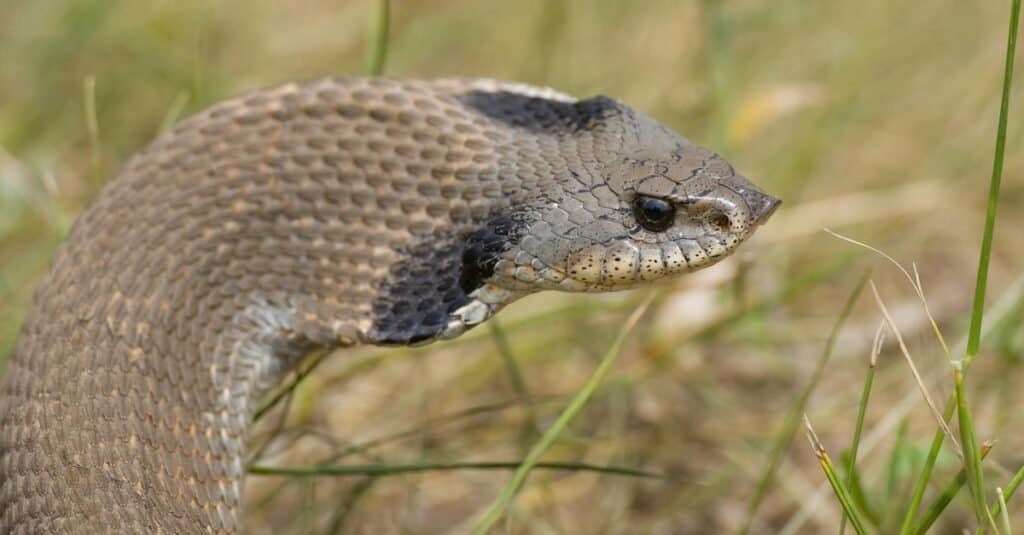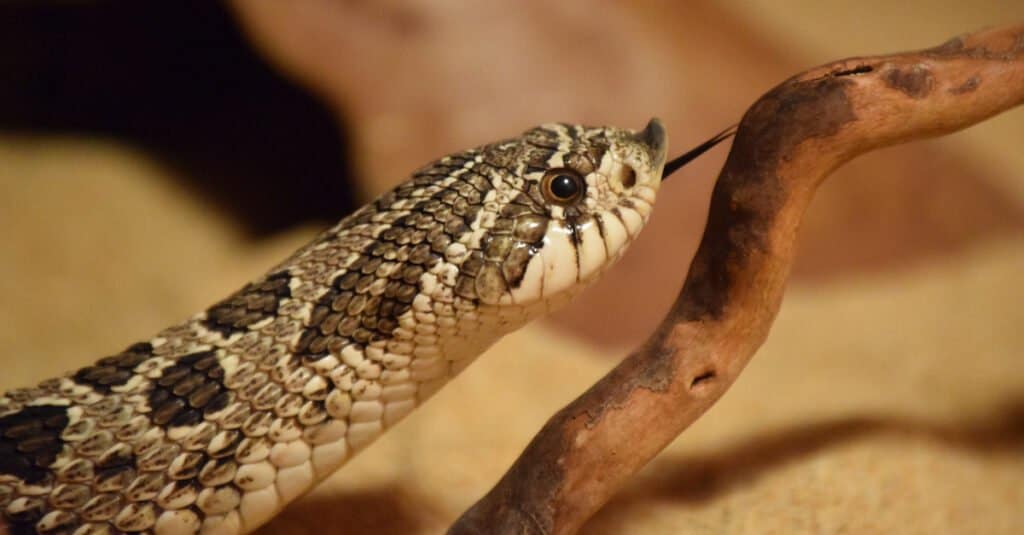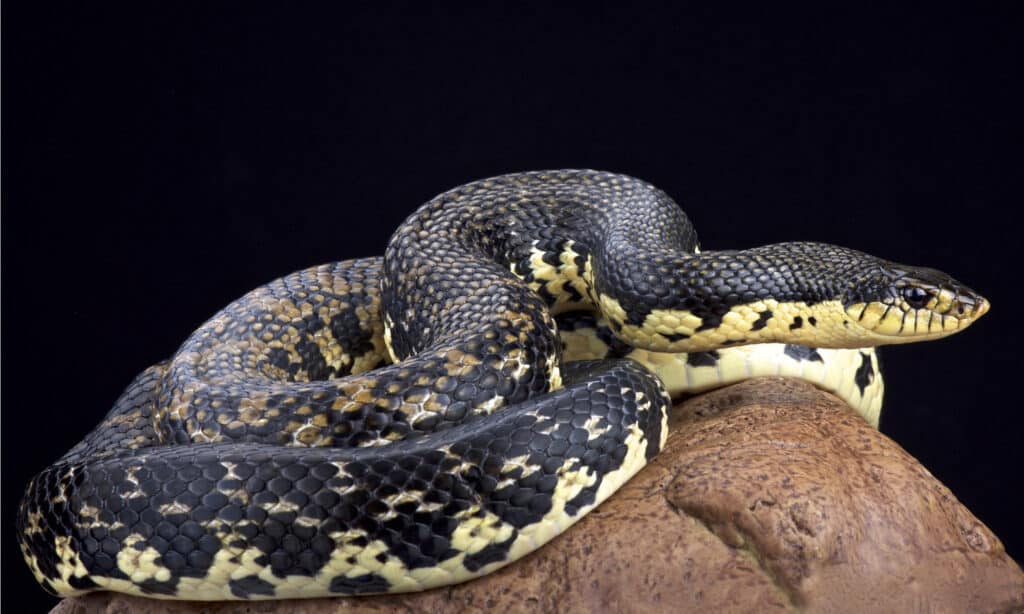There are multiple types of hognose snakes like the western hognose snake, the snow hognose snake, and a number of other varying species that live in a wide variety of habitats in Madagascar and the Americas. Some varieties have overlapping territories.
One thing all these hognose snakes have in common is their upturned pig-like nose. They also tend to be the color of the habitat they inhabit. They’re considered nonvenomous, though that’s up for debate.
What other incredible facts should you know about hognose snakes? We’ll take a closer look at some details now.
The 8 Incredible Hognose Snake Facts
- Hognose snakes have saliva that’s venomous. It hardly affects humans, but it’s lethal to the small prey they eat.
- Hognose snakes play dead when their other attempts to intimidate don’t work. They’re alert the entire time they’re doing this act, and they defecate while emitting an unpleasant smell during this display.
- Hognose snakes have an altered rostral scale which gives them their pig-nosed appearance. They use this scale to dig into burrows or search for prey like toads.
- Hognose snakes try to mimic a cobra by flattening themselves and hissing. They also make their head more triangular like a viper. If this doesn’t work, they play dead.
- Hognose snakes make great pets because their venom doesn’t hurt humans, they don’t bite much, and they’re usually relatively small.
- The state of Missouri is protecting a type of hognose snake called the dusty hognose from extinction, though no one else recognizes it exists.
- There is a hognose snake in Madagascar that is 6 feet long. This snake isn’t a good pet choice.
- The hognose snake has fangs in the back of its mouth instead of the front. That’s because it’s the saliva of the snake that’s toxic, not injectable venom.
Hognose Snake: A Nonvenomous Snake With Venom?

Hognose snakes have venom, but the venom isn’t harmful to humans.
©Steve Oehlenschlager/Shutterstock.com
Hognose snakes have venom that kills their food but doesn’t harm people. Some people think this venom is a poison since it isn’t injected and is applied topically by a saliva gland.
Studies have shown that some hognose snake bites react as if they have mild venom administered. When they strike, they usually do so with a closed mouth. Whatever venomous properties these hognose snakes may have are so mild that many people keep them as pets.
Some Hognose Snakes Play Dead
Some hognose snakes, especially the eastern hognose snake, play dead when threatened, and their other defensive tactics haven’t worked. Some hognose snakes even play dead in the water, but those in captivity usually stop playing dead.
They’ll roll over with their stomachs exposed, leave their mouths hanging open, convulse a few times, then hold perfectly still. If they’re flipped back onto their bellies while doing this, they roll back over and keep playing dead.
Baby snakes have been shown to play dead as well, so the behavior isn’t learned. Just because a hognose snake is feigning its death doesn’t mean it isn’t alert to its surroundings.
The entire time this happens, the snake may also be defecating and emitting a foul smell from a gland designed to do just that. The point is to smell like something that has died, and firsthand reports say it does a good job doing just that.
The Hognose Snake’s Nose Is Meant For Digging

Hognose snakes have an upturned scale at the tip of their nose that helps them dig through sand and loose soil.
©Bryn Thomas/Shutterstock.com
The hognose snake has its upturned nose because it uses it to burrow in the dirt, the sand, and other substrates. A snake’s nose scale is called a rostral, and the hognose has the most unique. It’s looking for whatever its preferred diet is, from crayfish to toads.
Hognose Snakes Mimic Cobras
The hognose snake tries to look like a cobra by flattening its neck and head while hissing loudly. This hissing is sometimes seen as blowing, which is how it got the name blowing adder.
While they are commonly known as puff adders for the same reason, they are completely different from the viper of the same name. All this flattening and distorting make their head look more triangular like vipers.
Hognose Snakes Make Great Pets
Hognose snakes are small compared to other snakes, so they’re easier to keep as pets. Some are as big as four feet, but they’re generally around two feet long.
There are laws in Colorado around owning western hognose snakes, so make sure you understand the rules if you’re in CO. These snakes can live up to 20 years in captivity, so they’re a commitment.
Snakes that are in captivity don’t eat toads and frogs. Instead, they are fed dead mice. The mice are dead because there’s a chance that a live rodent can seriously injure your snake as it tries to escape.
Some snakes don’t like the mouse meal substitute, but there are ways to make a mouse smell like a frog. Pet hognose snakes occasionally bite, but usually, it’s so light it doesn’t even break the skin.
The Dusty Hognose And The State Of Missouri
While the International Union for Conservation of Nature and Natural Resources doesn’t recognize the western hognose as distinct from the dusty hognose, the state of Missouri disagrees. They believe that the dusty hognose snake is a distinct species that are critically endangered.
The Madagascar Giant Hognose Snake

There are three different types of giant hognose snakes in Madagascar.
©reptiles4all/Shutterstock.com
These snakes are the largest of any of the hognose snakes on earth, and they also have a large scale on their nose, which they sweep side to side when using to dig for prey or find burrows.
There are three different types found nowhere else in the world except Madagascar, which is a common occurrence on that island. These hognose snakes can grow up to 6 feet in length and make terrible pets.
Hognose Fangs Are In The Back Of The Mouth
Hognose snakes do not inject venom. Instead, they have fangs in the back of their mouths that pierce their prey once they’ve secured it in their mouths, allowing their toxic saliva to subdue the animal. Then, like most snakes, they eat the animal whole.
The photo featured at the top of this post is © iStock.com/deepspacedave
Discover the "Monster" Snake 5X Bigger than an Anaconda
Every day A-Z Animals sends out some of the most incredible facts in the world from our free newsletter. Want to discover the 10 most beautiful snakes in the world, a "snake island" where you're never more than 3 feet from danger, or a "monster" snake 5X larger than an anaconda? Then sign up right now and you'll start receiving our daily newsletter absolutely free.
Thank you for reading! Have some feedback for us? Contact the AZ Animals editorial team.







